Family : Chrysomelidae

Text © Prof. Giorgio Venturini

English translation by Mario Beltramini
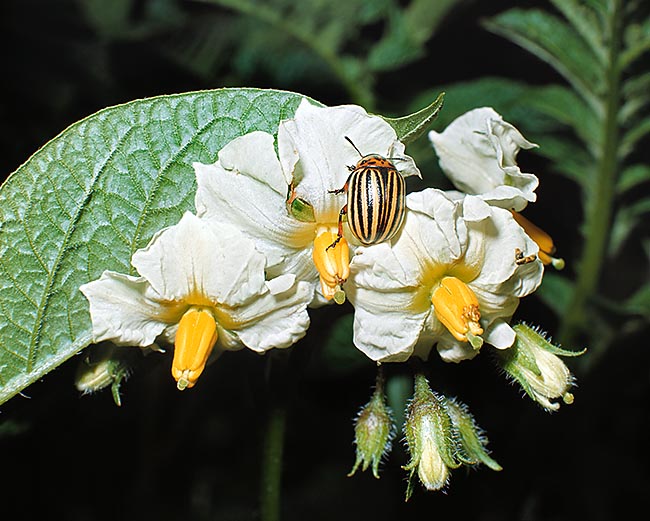
Native to North America, Leptinotarsa decemlineata is a real pest for potato cultivations © Giuseppe Mazza
The infamous terrible Colorado potato beetle (Doryphora decemlineata, nowadays known as Leptinotarsa decemlineata Say, 1824) is a Coleopteran (Coleoptera) belonging to the family of the Chrysomelids (Chrysomelidae). The name of the old genus Doryphora comes from the Greek “δορυ” (dory) = spear and “φερω” (fero) = to carry, therefore, carrier of spear, due to the maxillary palps ending in a spear-shaped article. The name of the new genus Leptinotarsa comes from the Greek “λεπτυνω” (leptyno) = to thin, therefore with thinned tarsi. The name of the species decemlineata comes from the Latin and refers to the ten black stripes on the elytra.
To the genus Leptinotarsa, native to northern America, belong about 30 species. Very similar to the Leptinotarsa decemlineata is the Leptinotarsa juncta (Germar), called the “false potato beetle” because of its resemblance. It is present in the south-eastern regions of the USA and nourishes of various wild solanaceous, but not of the potato. It distinguishes from the true potato beetle due to the white and black stripes on the elytra, instead of orange and black.
Zoogeography
The Leptinotarsa decemlineata is native to North America, probably of the regions near the Rocky Mountains in the South-West of the USA. From its origin area, it has then diffused, adapting to the potato cultivations. Nowadays it is present in all the USA (but Alaska, California, Nevada and Hawaii), Mexico, Central America, and southern Canada. The species has later on diffused in Europe, in the Mediterranean basin and in part of Asia.
Ecology-Habitat
The preferred host plant is the potato, but the Colorado potato beetle may feed on various species of solanaceous such as, for instance, the deadly nightshade, the eggplant, the Black nightshade (Solanum nigrum), the bittersweet nightshade, the tomato, the henbane and the tobacco (besides some wild solanaceous). They can also be found on non-solanaceous plants, but these are considered as casual finds. The prolificacy and the voracity of this insect, as adult as well as larva, render it a real pest for the cultivations of potatoes which has created in many instances very serious damages.
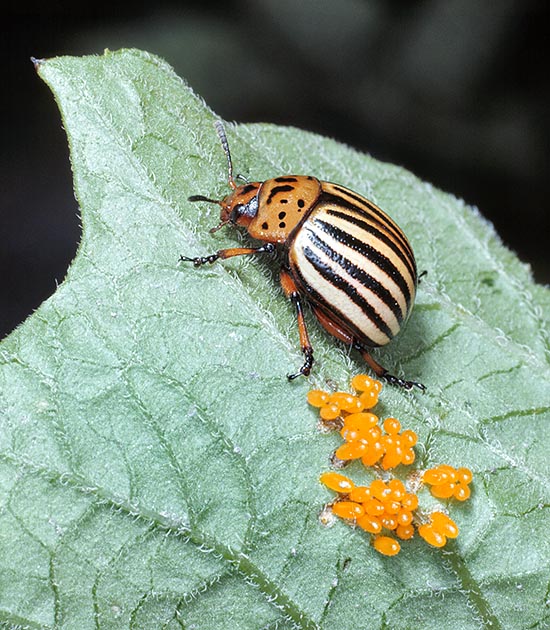
May lay 300-1000 eggs, in groups of 20-40, hatching in 4-15 days © Giuseppe Mazza
Morpho-physiology
The adult, oval and much convex, is about 10-12 mm long. The surface is glossy; the background colour is yellow ochre. Each elytron is crossed by five black longitudinal lines. The head has a triangular black spot. The ample pronotum and the legs, both orange, have dark spots irregular as size and as shape. The legs have the third tarsal segment dilated. The elytra are finely dotted. The lower part of the body is usually brown-orange. Males and females are morphologically very similar and difficult to distinguish.
The larva, with masticator buccal apparatus, is oligopod (equipped with thoracic legs), with body well differentiated in head, thorax, abdomen, 10-12 mm long, of yellow-orange colour but the head and the legs are black. The prothorax is partially black and the abdomen has two rows of black spots in relief.
The larva is inflated and the abdomen is strongly convex. The pupa, motionless, is yellowish and has less showy spots than the larva. The egg has the shape of a rugby ball: ovoid and about 1,6 mm long. The chorion is smooth and yellow-orange. The eggs are found in groups of 20-40, usually fixed on the lower page of the leaves.
The life cycle
The adults spend the winter in the ground, interred of about 20-40 cm. They come out when the temperature of the soil exceeds the 14 °C. The matings take place in spring and are followed by the spawning.
A female lays 300 to 1000 eggs during her four or five weeks of life. The eggs are laid in groups of 20-40 on the leaves of the host plant, usually on the lower page to protect them from the sun. The female produces a yellowish adhesive secretion it uses for fixing the eggs to the leaves. The eggs hatch in 4-15 days, depending on the humidity and the temperature, and produce larvae which, in 10-20 days pass through three moults at the end of which they fall on the ground, where they inter at a depth of 5-15 cm.
After about two days they transform in pupae that, in one or two weeks produce the adults of the first generation of the year. These mate and produce the second generation adults, which usually will be those hibernating under the soil. If the local conditions are favourable, as, for instance, happens in southern Italy, also the second generation will be able to reproduce originating a third one whose adults will inter for the hibernation. In some cases, some adults may remain interred for more consecutive years. The adults generally nourish on the leaves for about ten days before mating. The larvae nourish almost uninterruptedly before pupating.
The Colorado potato beetle, like other species of Leptinotarsa, produces the leptinotarsin, a neurotoxin stimulating the release of the acetylcholine at level of the synapses. This substance is highly toxic for the insects as well as for the vertebrates. A quite similar toxin, produced by an African chrysomelid, the Diamphidia, is used by the Bushmen San hunters for poisoning their arrows.
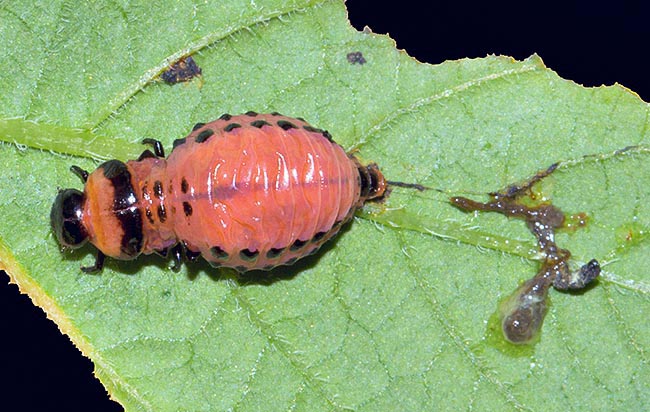
As the aposematic larvae colour indicates, the hemolymph and faces are toxic to many predators © Venturini
History
The Colorado potato beetle has been observed for the first time in the Rocky Mountains by Thomas Nuttal in 1811, and later on described by Thomas Say in 1824.
The first specimens have been collected on a spontaneous spiny solanaceous, the Solanum rostratum (Kansas thistle, or Texas thistle, or Buffalo bur).
The passage to the potato as host (Solanum tuberosum) has been observed in Nebraska in 1859. Since then the Colorado potato beetle has rapidly transformed in a pest, expanding eastward up to the Atlantic coast in 1874.
Curious is the origin of the American name of “Colorado potato beetle”, presently used: during the first years they used other names, such as “ten-lined potato beetle” or “potato-bug”. The connection with Colorado dates 1865, when many specimens were sighted in that State and this led to think that its origin was there. Finally, in 1867, Riley coined the term “Colorado potato beetle”.
In 1865 somebody estimated that the ten-lined potato beetle moved eastwards at about 8 km per hour; in 1871 the Detroit River was literally covered by insects, which then crossed the Lake Erie on board of whatever floating object. The New York Times describes swarms of Colorado potato beetles covering the train rails whose wheels skidded on the mass of on sects as if they were running on oil.
In the years 1870 the Colorado potato beetle entered the Americans life so much that were fashionable dresses for ladies in yellow and black stripes, the musical instrument mandolin was renamed “taterbug” (tater is a term of the American slang indicating the potato) and there were cartoons about Colorado potato beetles who, on the telephone directory were looking for the address of firms trading potatoes.
The first attempts to curb this invasion which was destroying the potato fields, at a time when valid insecticides did not exist, turned toward possible animals predators of the Colorado potato beetle. Numerous are the birds which may nourish of this chrysomelid and the countrymen did choose the poultry, which was left free in the fields.
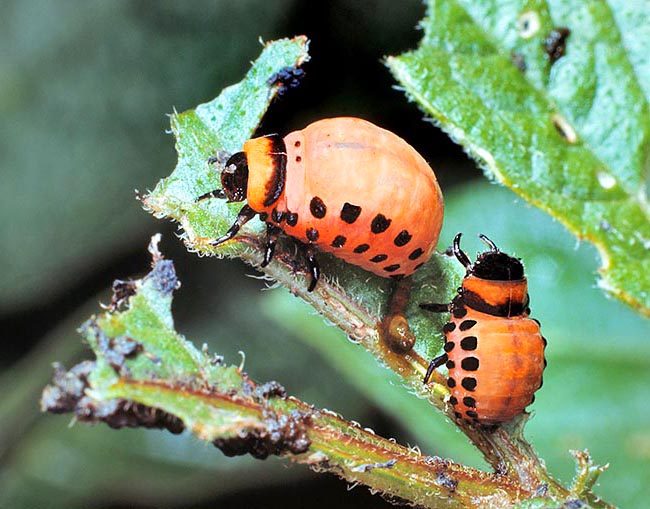
In 10-20 days larvae get through three moults and then fall on the ground © Giuseppe Mazza
In the cultivations, they manly used the method of manual collection and destruction of the parasites.
The Leptinotarsa arrived in Europe in 1876 and the following year it was reported in England, where in 1901 happened a serious infestation (in England, presently, the Colorado potato beetle has been eradicated). The diffusion in the European continent began in France, from where, then, it amply diffused.
During the World War I, the French did call the German soldiers “Doryphore” due to the shape of their helmets.
During Nazism, in Germany the population was mobilized to hunt the Colorado potato beetle and with a reward of some Pfennig for each specimen destroyed. Word got around that the Allies scattered the Colorado potato beetles on the German fields in order to cause damage to the economy. The idea was resumed after the Second World War by the propaganda of the Eastern countries, which accused the western imperialists of artificially introducing the Colorado potato beetles and leaflets did circulate showing the greedy imperialist aggressor parachuted, depicted with the face of Uncle Sam and with the top hat. In 1950, in Spain, a leaflet invited the children to spend the vacations disinfesting manually the potatoes.
In Italy, the first reports were done during the Second World War (1943) in Piedmont, and since then it has spread all over the Peninsula. Several texts unfairly attribute the Colorado potato beetle the responsibility of the destruction of the potato cultivations which caused between 1848 and 1848 the tragic famine happened in Ireland which decimated the population of the island. Actually, the cultivations were attacked by the potato blight (Phytophthora infestans), an Oomycete.
Impact on the crops of potatoes, enemies of the Colorado potato beetle, biological and chemical struggle
Presently, the Colorado potato beetle is the most dangerous insect in the cultivation of the potato and of other Solanaceous. Leptinotarsa decemlineata is one of the most diffused and a destructive scourge for the potato, which often causes a complete loss of the leaves of the attacked plants. In some countries of the Mediterranean area, the loss of production is of the 50%.
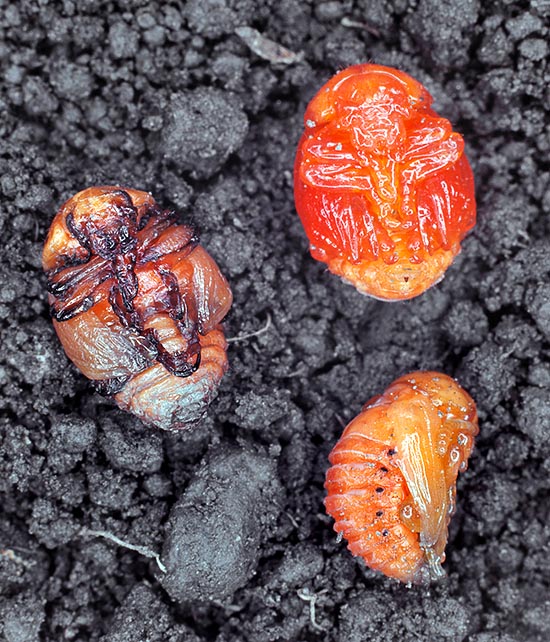
They inter 5-15 cm deep and in two days they turn pupae © Giuseppe Mazza
With meteorological and ambient favourable situations, the population of Colorado potato beetle may increase dramatically (they calculate that even in case of a death rate of the eggs of the 90%, and with a normal death rate of the larvae, in absence of controlling interventions, a single pair may produce in five years up to thousand billion of specimens. Furthermore, it is possible that the Colorado potato beetle determines the diffusion of other pathologies of the potato, such as the bacterium Ralstonia solanacearum.
The Colorado potato beetle can also seriously damage other solanaceous, such as the eggplant and the tobacco. Several species of the genus Leptinotarsa are parasitized by Carabid coleopterans of the genus Lebia: Lebia grandis is a predator of the eggs and the larvae of Colorado potato beetle and is a parasitoid of its pupae. In North America, it is used for the biological pest control, whilst it has not yet been introduced in Italy.
The Hyphomycete Beauveria bassiana is a pathogenic fungus attacking many insects, among which the Colorado potato beetle. This hiyphomycete is the most utilized natural enemy in the struggle against the Colorado potato beetle and preparations are commercially available to be used in the potato plantations by means of normal spraying dispensers for pesticides.
In the biological struggle against Leptinotarsa have averred valid the Bacillus thuringiensis ssp. tenebrionis and the Bacillus thuringiensis ssp. Kurstaki. (The Bacillus thuringiensis is a sporogenic bacterium of the soil. When ingested, it frees toxins, absolutely harmless for the man, but very toxic for various insects. It is amply utilized in the biological struggle as insecticide and also for the creation of transgenic plants expressing the toxin and therefore becoming toxic for the parasites).
They have also introduced the use of a hymenopter of Central-American origin, the Edovum puttleri, parasitoid of the eggs, with promising results. Another important parasitoid is the Tachinid Diptera Myiopharus doryphorae.
The chemical struggle traditionally utilized has proved good, but it needs always new compounds, since that presently the Colorado potato beetle is resistant to at least 25 insecticides commonly used in agriculture. In any case, the use of the insecticides is still now the most diffuse means of control and in many countries the treatments are compulsory. Presently, in the countries where controls and treatments are regularly carried on, the infestation remains under control. They are studying synthetic pheromones which might be utilized for interfering in the interactions male-female.
The Colorado potato beetle has developed an interesting mechanism of defence against tome predators, taking advantage from the toxicity of its own faeces. In fact, the larva often surrounds and covers itself of faeces, which are poisonous and repellent for many insects. They have thought that this toxicity may be related with an accumulation in the faeces of toxic substances, such as the solanine, which are contained in the leaves of the solanaceous of which the insect nourishes, but there are no proofs in favour of this hypothesis.
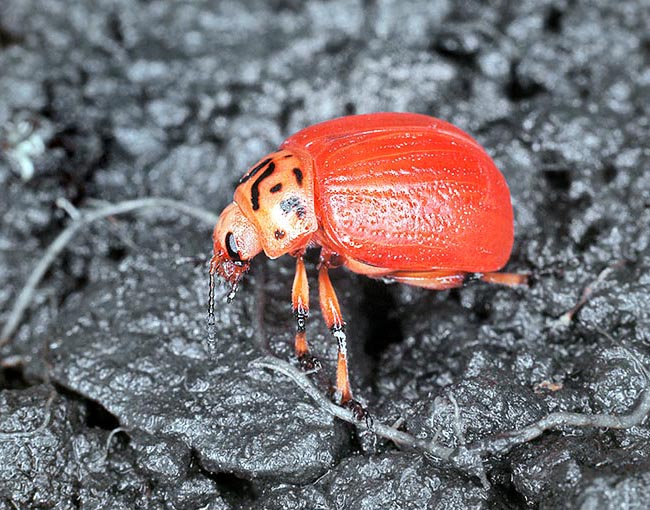
In 1-2 weeks the adults get out from the soil. Here is an odd red elytra variant © Giuseppe Mazza
It is more likely that the toxicity is due to the leptinotarsin or other substances. In any case, besides the faeces also the haemolymph of the Colorado potato beetle is toxic for many predators. Probably, the showy aposematic colouration (are called aposematic those colourations, typical of poisonous or repellent species, which have the function of warning the possible predator) represents an advice about its toxicity sent to the predators.
An interesting case of coevolutional adaptation has occurred between solanaceous and Colorado potato beetle: following an attack of insects, in the leaves of the potato are produced molecules inhibiting the digestion of the proteins by the parasite, which therefore will get a reduction n the growth and in the fecundity.
These inhibiting molecules represent consequently an important self-defence of the potato against its parasites. The Colorado potato beetle implements a counter-defence producing digestive enzymes insensible to the inhibitors produced by the potato and therefore can nourish with impunity of its leaves.
Even better, the Colorado potato beetle is in condition to produce an inhibitor of the inhibitor and so with two different strategies fights back the defences of the potato (this is good for the non believers in the evolution!).
Recently, they have hypothesized an interesting strategy of defence of the potato cultivations, after having observed that the digestive apparatus of the Colorado potato beetle is not completely insensible to the affects of some substances contained in the leaves of the potato, functionally similar to the leptins and capable to inhibit the metabolism and the assumption of food (the leptins of the mammals are hormones acting on the brain regulating the appetite and the metabolism and control the body weight). It has been therefore thought to produce hybrids of potato with high content of leptins and in reality these hybrids are scarcely aggressed by the Colorado potato beetles. It is not known if this could have any practical applications in agriculture.
Synonyms
Doryphora decemlineata Say, 1824; Doryphora decemlineata Roger, 1990; Leptinotarsa multitaeniata Stål, 1859; Chrysomela decemlineata Say, 1824; Leptinotarsa decemlineata Kraatz, 1874; Leptinotarsa intermedia Tower, 1906; Leptinotarsa oblongata Tower, 1906; Leptinotarsa rubicunda Tower, 1906; Polygramma decemlineata Mlelié, 1990; Polygramma decemlineata Mels, 1982.
→ For general notions about Coleoptera please click here.
→ To appreciate the biodiversity within the BEETLES please click here.
